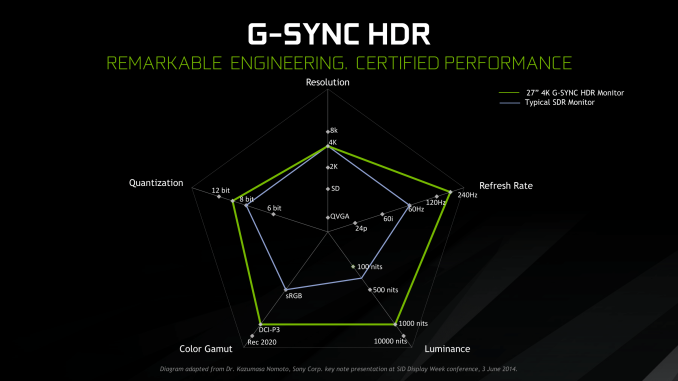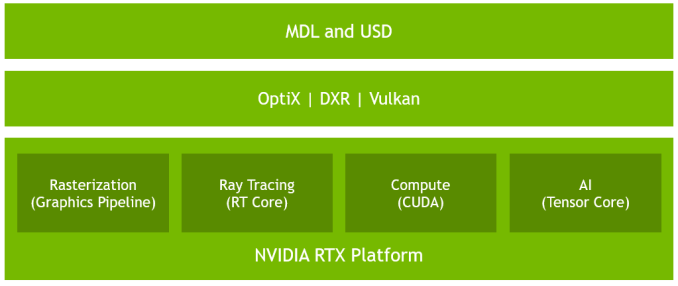The NVIDIA GeForce RTX 2080 Ti & RTX 2080 Founders Edition Review: Foundations For A Ray Traced Future
by Nate Oh on September 19, 2018 5:15 PM EST- Posted in
- GPUs
- Raytrace
- GeForce
- NVIDIA
- DirectX Raytracing
- Turing
- GeForce RTX
Meet The New Future of Gaming: Different Than The Old One
Up until last month, NVIDIA had been pushing a different, more conventional future for gaming and video cards, perhaps best exemplified by their recent launch of 27-in 4K G-Sync HDR monitors, courtesy of Asus and Acer. The specifications and display represented – and still represents – the aspired capabilities of PC gaming graphics: 4K resolution, 144 Hz refresh rate with G-Sync variable refresh, and high-quality HDR. The future was maxing out graphics settings on a game with high visual fidelity, enabling HDR, and rendering at 4K with triple-digit average framerate on a large screen. That target was not achievable by current performance, at least, certainly not by single-GPU cards. In the past, multi-GPU configurations were a stronger option provided that stuttering was not an issue, but recent years have seen both AMD and NVIDIA take a step back from CrossFireX and SLI, respectively.
Particularly with HDR, NVIDIA expressed a qualitative rather than quantitative enhancement in the gaming experience. Faster framerates and higher resolutions were more known quantities, easily demoed and with more intuitive benefits – though in the past there was the perception of 30fps as cinematic, and currently 1080p still remains stubbornly popular – where higher resolution means more possibility for details, higher even framerates meant smoother gameplay and video. Variable refresh rate technology soon followed, resolving the screen-tearing/V-Sync input lag dilemma, though again it took time to catch on to where it is now – nigh mandatory for a higher-end gaming monitor.
For gaming displays, HDR was substantively different than adding graphical details or allowing smoother gameplay and playback, because it meant a new dimension of ‘more possible colors’ and ‘brighter whites and darker blacks’ to gaming. Because HDR capability required support from the entire graphical chain, as well as high-quality HDR monitor and content to fully take advantage, it was harder to showcase. Added to the other aspects of high-end gaming graphics and pending the further development of VR, this was the future on the horizon for GPUs.
But today NVIDIA is switching gears, going to the fundamental way computer graphics are modelled in games today. Of the more realistic rendering processes, light can be emulated as rays that emit from their respective sources, but computing even a subset of the number of rays and their interactions (reflection, refraction, etc.) in a bounded space is so intensive that real time rendering was impossible. But to get the performance needed to render in real time, rasterization essentially boils down 3D objects as 2D representations to simplify the computations, significantly faking the behavior of light.
It’s on real time ray tracing that NVIDIA is staking its claim with GeForce RTX and Turing’s RT Cores. Covered more in-depth in our architecture article, NVIDIA’s real time ray tracing implementation takes all the shortcuts it can get, incorporating select real time ray tracing effects with significant denoising but keeping rasterization for everything else. Unfortunately, this hybrid rendering isn’t orthogonal to the previous concepts. Now, the ultimate experience would be hybrid rendered 4K with HDR support at high, steady, and variable framerates, though GPUs didn’t have enough performance to get to that point under traditional rasterization.
There’s a still a performance cost incurred with real time ray tracing effects, except right now only NVIDIA and developers have a clear idea of what it is. What we can say is that utilizing real time ray tracing effects in games may require sacrificing some or all three of high resolution, ultra high framerates, and HDR. HDR is limited by game support more than anything else. But the first two have arguably minimum performance standards when it comes to modern high-end gaming on PC – anything under 1080p is completely unpalatable, and anything under 30fps or more realistically 45 to 60fps hurts the playability. Variable refresh rate can mitigate the latter and framedrops are temporary, but low resolution is forever.
Ultimately, the real time ray tracing support needs to be implemented by developers via a supporting API like DXR – and many have been working hard on doing so – but currently there is no public timeline of application support for real time ray tracing, Tensor Core accelerated AI features, and Turing advanced shading. The list of games with support for Turing features - collectively called the RTX platform - will be available and updated on NVIDIA's site.













337 Comments
View All Comments
AnnoyedGrunt - Friday, September 21, 2018 - link
I think it was actually much less, judging by comments made in one of the reviews I linked. Maybe around $350 or so, which was very expensive at the time. It is true that it was a revolutionary card, but at the same time it was greeted with a lukewarm reception from the gaming community. Much like the 20XX series. I doubt that the 20XX will seem as revolutionary in hindsight as the GeForce256 did, but the initial reception does seem similar between the two. Will be interesting to see what the next year brings to the table.-AG
eddman - Friday, September 21, 2018 - link
Wow, that's just $525 now. I'm interested in old card prices because some people claim they have always been super expensive. It seems they have a selective memory. I'm yet to find a card more expensive than 2080 Ti from that time period.I'm not surprised that people still didn't buy many 256 cards. The previous cards were cheaper and performed close enough for the time.
abufrejoval - Thursday, September 20, 2018 - link
I am pretty sure I'll get a 2080ti, simply because nothing else will run INT4 or INT8 based inference with similar performance and ease of availability and tools support. Sure, when you are BAIDU or Facebook, you can buy even faster inference hardware or if you are Google you can build your own. But if you are not, I don't know where you'll get something that comes close.As far as gaming is concerned, my 1080ti falls short on 4k with ARK, which is noticeable at 43". If the 2080ti can get me through the critical minimum of 30FPS, it will have been worth it.
As far as ray tracing is concerned, I am less concerned about its support in games: Photo realism isn't an absolute necessity for game immersion.
But I'd love to see hybrid render support in software like Blender: The ability to pimp up the quality for video content creation and replace CPU based rander farms with something that is visually "awsome enough" points towards the real "game changing" capacity of this generation.
It pushes three distinct envelopes, raster, compute and render: If you only care about one, the value may not be there. In my case, I like the ability to explore all three, while getting an 2080ti for me allows me to push down an 1070 to one of my kids still running an R290X: Christmas for both of us!
mapesdhs - Thursday, September 27, 2018 - link
In the end though that's kinda the point, these are not gaming cards anymore and haven't been for some time. These are side spins from compute, where the real money & growth lie. We don't *need* raytracing for gaming, that glosses over so many other far more relevant issues about what makes for a good game.Pyrostemplar - Thursday, September 20, 2018 - link
High performance and (more than) matching price. nVidia seemingly put the card classification down one notch (x80 => x70; Ti => x80; Titan => Ti) while keeping the prices and overclocked then from day one so it looks like solid progress if one disregards the price.I think it will be a short lived (1 year or so) generation. A pricey stop gap with a few useless new features (because when devs catch up and actually deploy DXR enabled games, these cards will have been replaced by something faster).
ballsystemlord - Thursday, September 20, 2018 - link
Spelling/grammar errors (Only 2!):Wrong word:
"All-in-all, NVIDIA is keeping the Founders Edition premium, now increased to $100 to $200 over the baseline"
Should be:
"All-in-all, NVIDIA is keeping the Founders Edition premium, now increased from $100 to $200 over the baseline"
Missing "s":
"Of course, NVIDIA maintain that the cards will provide expected top-tier"
Should be:
"Of course, NVIDIA maintains that the cards will provide expected top-tier"
Ryan Smith - Thursday, September 20, 2018 - link
Thanks!ballsystemlord - Thursday, September 20, 2018 - link
Nate! Can you add DP folding @ home benchmark numbers? There were none in the Vega review and only SP in this Nvidia review.SanX - Thursday, September 20, 2018 - link
Author thinks that all gamers buy only fastest cards? May be. But I doubt all of them buy the new generestion card every year. In short, where are comparisons to 980/980Ti and even 780/780Ti? Owners of those cards are more interested to upgrade.milkod2001 - Friday, September 21, 2018 - link
See from top menu on right, there is a bench where you can see results. I presume they add data to huge database soon. And yes,people are talking about high end GPU but most are spending $400 max. for it.